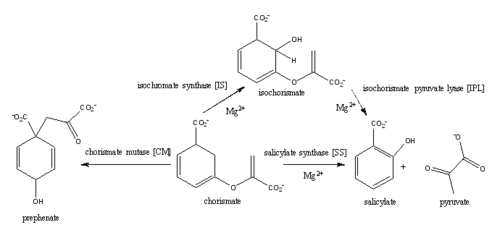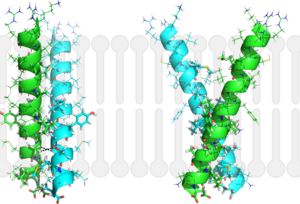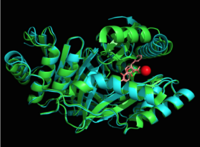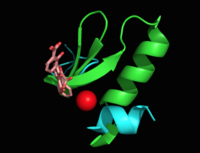Sandbox Reserved 1068
From Proteopedia
| Line 22: | Line 22: | ||
== Structural highlights == | == Structural highlights == | ||
| + | |||
| + | [[Image:Screen Shot 2015-04-26 at 6.31.19 PM.png|200 px|left|thumb|'''Figure 3:''' Overlay of chain A in [[3ST6]] (green) and [[3RV6]] (teal). [[3ST6]] contains the inhibitor AMT and represents the closed form of MbtI while [[3RV6]] contains an enolpyruvyl modified inhibitor (phenyl-AMT) and shows the movement of the backbone away from the closed form to accommodate the modified inhibitor. <ref name= "8a"/>.]]. | ||
| + | |||
| + | [[Image:Screen Shot 2015-04-26 at 6.29.56 PM.png|200 px|left|thumb|'''Figure 4:''' Overlay of chain A in [[3ST6]] (green) and [[3RV6]] (teal) with inhibitors bound and magnesium. <ref name= "8a"/>.]] | ||
| + | |||
| + | [[Image:Screen Shot 2015-04-26 at 6.30.55 PM.png|200 px|left|thumb|'''Figure 5:''' Flexibility of peptide backbone in regions proximal to the active site see through the overlay of chain A residues 269-293 and 324-336 in [[3ST6]] (green) and [[3RV6]] (teal)<ref name= "8a"/>.]]. | ||
| + | |||
MbtI structure has a mobile element (residues 268-293 and 324-336) that can adopt a <scene name='69/694235/Irp9_closed_state/2'>closed</scene> or <scene name='69/694235/2g5f_with_open_loop/1'>open conformation</scene> depending on whether or not ligands are bound to the active site.<ref name="3a"/> The closed conformation partially obstructs the active site. <ref name= "5a"/>. | MbtI structure has a mobile element (residues 268-293 and 324-336) that can adopt a <scene name='69/694235/Irp9_closed_state/2'>closed</scene> or <scene name='69/694235/2g5f_with_open_loop/1'>open conformation</scene> depending on whether or not ligands are bound to the active site.<ref name="3a"/> The closed conformation partially obstructs the active site. <ref name= "5a"/>. | ||
Inhibition studies have also shown a switch in binding mode at the MbtI active site for inhibitors carrying a substituted enolpyruvyl group compared to the chorismate substrate <ref name="5a">PMID:22607697</ref> <ref name= | Inhibition studies have also shown a switch in binding mode at the MbtI active site for inhibitors carrying a substituted enolpyruvyl group compared to the chorismate substrate <ref name="5a">PMID:22607697</ref> <ref name= | ||
"2a">PMID:23108268</ref> <ref name="1a">PMID:20512795</ref>. Crystal structures and fluorescent-based thermal shift assays show that substituents larger than a methyl group are accommodated in the active site of MbtI through localized flexibility in the peptide backbone.<ref name="5a"/> Positioning of the <scene name='69/694235/3st6_structure_bindingpocket/3'>active site residues</scene> of MbtI in [[3ST6]] with the inhibitor AMT bound is highly similar to the positioning of the <scene name='69/694235/3log_bindingpocket/3'>active site residues</scene> in closed form of MbtI [[3log]] with succinic acid bound <ref name= "5a"/>. The AMT inhibitor contains an unmodified enolpyruvyl side chain and resembles the structure of the natural substrate, chorismate. [[3log]] and [[3ST6]] are shown to share a similar binding mode, termed binding mode 1. Isochorismate inhibitors with modified enolpyruvl side chains ([[3VEH]], [[3RV9]], [[3RV8]], [[3RV7]], [[3RV6]]) utilize a novel binding mode, termed mode 2, which involves the <scene name='69/694235/3veh_structure_bindingpocket2/2'>reorientation of the isochorismate analogue within the active site</scene>. Movement of the peptide backbone away from the closed form of MbtI is required to accommodate the enolpyruyl modified inhibitors. | "2a">PMID:23108268</ref> <ref name="1a">PMID:20512795</ref>. Crystal structures and fluorescent-based thermal shift assays show that substituents larger than a methyl group are accommodated in the active site of MbtI through localized flexibility in the peptide backbone.<ref name="5a"/> Positioning of the <scene name='69/694235/3st6_structure_bindingpocket/3'>active site residues</scene> of MbtI in [[3ST6]] with the inhibitor AMT bound is highly similar to the positioning of the <scene name='69/694235/3log_bindingpocket/3'>active site residues</scene> in closed form of MbtI [[3log]] with succinic acid bound <ref name= "5a"/>. The AMT inhibitor contains an unmodified enolpyruvyl side chain and resembles the structure of the natural substrate, chorismate. [[3log]] and [[3ST6]] are shown to share a similar binding mode, termed binding mode 1. Isochorismate inhibitors with modified enolpyruvl side chains ([[3VEH]], [[3RV9]], [[3RV8]], [[3RV7]], [[3RV6]]) utilize a novel binding mode, termed mode 2, which involves the <scene name='69/694235/3veh_structure_bindingpocket2/2'>reorientation of the isochorismate analogue within the active site</scene>. Movement of the peptide backbone away from the closed form of MbtI is required to accommodate the enolpyruyl modified inhibitors. | ||
| - | |||
| - | [[Image:Screen Shot 2015-04-26 at 6.29.56 PM.png|300 px|center|thumb|Figure 3: Isochorismate pyruvate activity <ref name= "8a"/>.]] | ||
==Molecular Mechanism== | ==Molecular Mechanism== | ||
'''Magnesium cation effect''' | '''Magnesium cation effect''' | ||
| + | |||
[[Image:Screen Shot 2015-04-25 at 11.08.58 PM.png |300 px|left|thumb|'''Table 1:''' pKa values of active site residues of MbtI with and without Magnesium. <ref name="8a"/> 2-11.]] The presence of the [http://en.wikipedia.org/wiki/Magnesium_in_biology magnesium ion] induces changes in the structure of the active site and in the substrate, as well as causes significant pKa shifts in some of the key residues involved in the catalytic activity (Table 1).The <scene name='69/694235/3rv6_mg_shell/4'>coordination shell</scene>of the magnesium cation in the active site of MbtI in [[3rv6]] with phenyl-AMT inhibitor bound is composed of two water molecules, Glu434, Glu294, and the two oxygen atoms of the C1 carboxylate group of chorismate. In the presence of the magnesium ion, the positively charged Lys295 is displaced from the active site and the negatively charged Glu297 is faced toward the active site. Magnesium cation also orients the C1 carboxylate group coplanar to the ring of chorismate, reducing the electron density on the C2 center and favoring nucleophilic attack<ref name= "8a">PMID:22307014</ref>. | [[Image:Screen Shot 2015-04-25 at 11.08.58 PM.png |300 px|left|thumb|'''Table 1:''' pKa values of active site residues of MbtI with and without Magnesium. <ref name="8a"/> 2-11.]] The presence of the [http://en.wikipedia.org/wiki/Magnesium_in_biology magnesium ion] induces changes in the structure of the active site and in the substrate, as well as causes significant pKa shifts in some of the key residues involved in the catalytic activity (Table 1).The <scene name='69/694235/3rv6_mg_shell/4'>coordination shell</scene>of the magnesium cation in the active site of MbtI in [[3rv6]] with phenyl-AMT inhibitor bound is composed of two water molecules, Glu434, Glu294, and the two oxygen atoms of the C1 carboxylate group of chorismate. In the presence of the magnesium ion, the positively charged Lys295 is displaced from the active site and the negatively charged Glu297 is faced toward the active site. Magnesium cation also orients the C1 carboxylate group coplanar to the ring of chorismate, reducing the electron density on the C2 center and favoring nucleophilic attack<ref name= "8a">PMID:22307014</ref>. | ||
Revision as of 22:59, 26 April 2015
Contents |
Mycobacterium tuberculosis salicylate synthase (Mbt1)
| |||||||||||
References
- ↑ 1.00 1.01 1.02 1.03 1.04 1.05 1.06 1.07 1.08 1.09 1.10 1.11 1.12 1.13 1.14 Ferrer S, Marti S, Moliner V, Tunon I, Bertran J. Understanding the different activities of highly promiscuous MbtI by computational methods. Phys Chem Chem Phys. 2012 Mar 14;14(10):3482-9. doi: 10.1039/c2cp23149b. Epub, 2012 Feb 3. PMID:22307014 doi:http://dx.doi.org/10.1039/c2cp23149b
- ↑ 2.0 2.1 2.2 2.3 2.4 2.5 2.6 2.7 Manos-Turvey A, Bulloch EM, Rutledge PJ, Baker EN, Lott JS, Payne RJ. Inhibition studies of Mycobacterium tuberculosis salicylate synthase (MbtI). ChemMedChem. 2010 Jul 5;5(7):1067-79. PMID:20512795 doi:10.1002/cmdc.201000137
- ↑ 3.0 3.1 Lamb AL. Pericyclic reactions catalyzed by chorismate-utilizing enzymes. Biochemistry. 2011 Sep 6;50(35):7476-83. doi: 10.1021/bi2009739. Epub 2011 Aug, 12. PMID:21823653 doi:http://dx.doi.org/10.1021/bi2009739
- ↑ 4.0 4.1 4.2 4.3 De Voss JJ, Rutter K, Schroeder BG, Su H, Zhu Y, Barry CE 3rd. The salicylate-derived mycobactin siderophores of Mycobacterium tuberculosis are essential for growth in macrophages. Proc Natl Acad Sci U S A. 2000 Feb 1;97(3):1252-7. PMID:10655517
- ↑ Zwahlen J, Kolappan S, Zhou R, Kisker C, Tonge PJ. Structure and mechanism of MbtI, the salicylate synthase from Mycobacterium tuberculosis. Biochemistry. 2007 Jan 30;46(4):954-64. PMID:17240979 doi:10.1021/bi060852x
- ↑ 6.0 6.1 6.2 6.3 6.4 6.5 6.6 6.7 Chi G, Manos-Turvey A, O'Connor PD, Johnston JM, Evans GL, Baker EN, Payne RJ, Lott JS, Bulloch EM. Implications of Binding Mode and Active Site Flexibility for Inhibitor Potency against the Salicylate Synthase from Mycobacterium tuberculosis. Biochemistry. 2012 Jun 7. PMID:22607697 doi:10.1021/bi3002067
- ↑ 7.0 7.1 7.2 7.3 7.4 7.5 7.6 Harrison AJ, Yu M, Gardenborg T, Middleditch M, Ramsay RJ, Baker EN, Lott JS. The structure of MbtI from Mycobacterium tuberculosis, the first enzyme in the biosynthesis of the siderophore mycobactin, reveals it to be a salicylate synthase. J Bacteriol. 2006 Sep;188(17):6081-91. PMID:16923875 doi:http://dx.doi.org/188/17/6081
- ↑ 8.0 8.1 8.2 Manos-Turvey A, Cergol KM, Salam NK, Bulloch EM, Chi G, Pang A, Britton WJ, West NP, Baker EN, Lott JS, Payne RJ. Synthesis and evaluation of M. tuberculosis salicylate synthase (MbtI) inhibitors designed to probe plasticity in the active site. Org Biomol Chem. 2012 Dec 14;10(46):9223-36. doi: 10.1039/c2ob26736e. Epub 2012, Oct 29. PMID:23108268 doi:http://dx.doi.org/10.1039/c2ob26736e
- ↑ 9.0 9.1 He Z, Stigers Lavoie KD, Bartlett PA, Toney MD. Conservation of mechanism in three chorismate-utilizing enzymes. J Am Chem Soc. 2004 Mar 3;126(8):2378-85. PMID:14982443 doi:http://dx.doi.org/10.1021/ja0389927
- ↑ Tuberculosis (TB). Ed. Sam Posner. Centers for Disease Control and Prevention, n.d. Web. 9 Apr. 2015.
Student contributors
Stephanie Raynor and Robin Gagnon
Related pdb files and proteopedia pages
3D structures of isochorismate pyruvate lyase
3log – MtIPL/isochorismate synthase - Mycobacterium tuberculosis
3rv6, 3rv7, 3rv8, 3rv9, 3st6, 3veh - MtIPL/isochorismate synthase + inhibitor
2h9c – PaIPL residues 1-99 – Pseudomonas aeruginosa
2h9d - PaIPL + pyruvate
3LOG
3D structure of isochorismate synthase
2eua, 3bzm, 3bzn - MenF from E. coli
3os6 - DhbC from Bacillus anthracis
3gse - MenF from Yersinia pestis
3hwo - EntC
3D structure of salicylate synthase
3veh - MbtI with inhibitor methylAMT
3st6 - MbtI with isochorismate analogue inhibitor
3rv6 (Phenyl R-group), 3rv7 (Isopropyl R-group), 3rv8 (Cyclopropyl R-group), 3rv9 (Ethyl R-group) - MbtI with inhibitor
2fn0, 2fn1 (with products salicylate and pyruvate) - Irp9 from Yersinia enterocolitica
2i6y - MbtI










